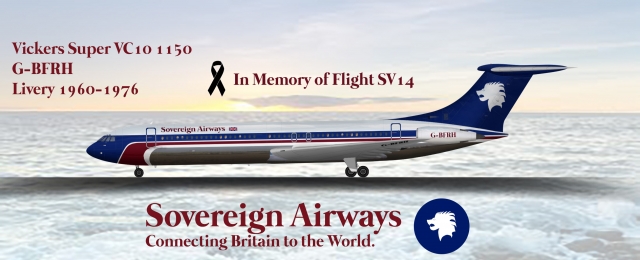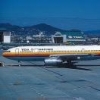Vickers Super VC10 Sovereign Airways with Updated Template
- Owner: Rigel (View all images and albums)
- Uploaded: Sep 08 2020 07:16 AM
- Taken: 2020:09:08 17:16:08
- Views: 2,076
- Album ZYX - Brands By Rigel
Template by POTKC + Fishermanivan. Logo and livery by Rigel

To read about the general history of Soveriegn Airways' VC10 fleet, read here: http://www.airline-e...rs-vc10-poster/
In general, Sovereign Airways's Vickers VC10 fleet served a reliable, long-lasting service life of 18 years with the airline. The plane was loved by all associated with it; Pilots loved the way the plane controlled and handled, passengers loved the low cabin noise, high speed, spacious cabin and smooth ride, while aviation enthusiasts loved the screaming Conway engines adorning the back of the beautiful aircraft. It was Sovereign Airway's most popular plane, and people would go out of their way to fly on it, even delaying their trip if they couldn't. However, not all of Sovereign Airways' VC10s made it all the way to the aircraft's retirement in 1982. One was lost over the Atlantic Ocean. This is the story of Flight SV14.
July 19th, 1974. 10:50 am. There was chaos at London Gatwick International Airport. A dense fog had set in around the airport. Flights were constantly being delayed, and there were traffic jams on the way to the runway.
One of the flights waiting to take off from the airport was Sovereign Airways Flight 14, bound for Montreal, Canada. On board were 115 passengers and six crew members. The captain for today's flight was Thomas Williams, age 54. With over 40,000 hours in the cockpit, the majority of them being in the VC10, he was a veteran of the plane. He was among Sovereign Airways' most experienced pilots, knowing the plane and the route well. His co-pilot was First Officer Marcus Dannahan, aged 41. While not quite as experienced as Captain Williams, he was still quite experienced, with 35,000 hours in the cockpit. The flight engineer was Second Officer Daniel Smith, aged 38. He was the least experienced of the group, with only 22,000 hours in his seat. At the time, he was in training to become a first officer, and according to his workmates, he was doing an "excellent job".
The aircraft operating the flight was a Vickers Super VC10 1150, Britain's final aircraft developed alone to challenge the Americans. While not popular with the airlines, the plane was incredibly loved by its passengers.
The flight was running late as a result of the fog, and the resulting delays from other flights. The pilots were a bit impatient with the delays, and were in a rush to get to the runway and take off. This was the plane's first flight of the day, even though it was supposed to take off an hour ago. The plane had been undergoing maintenance overnight, but the list of fixes was so extensive that by the time the mechanics got to the landing gear, they were told to get a move on, as there was only an hour and a half before the plane was supposed to take off. As a result, the left main landing gear and right main gear brakes maintenance was rushed.
The plane finally reached the runway at 10:55 am. At 10:57, it began its takeoff roll. However, the rushed maintenance job meant that one of the wheels began deflecting to the left, causing the plane to veer off in that direction. The pilot, not wanting to waste any more time by aborting the takeoff, tried to solve the problem by using right rudder and right brakes. Unfortunately, one of the brakes on the right main gear locked up, causing that wheel to stop rotating. The amount of friction caused by the tire against the runway was huge, so much that a self-sustained fire started on the main gear. However, the pilots didn't notice this, and it wasn't mentioned by ATC. Therefore, the plane continued its takeoff.
An hour or so after takeoff, the plane was just leaving British airspace, its passengers enjoying themselves greatly. Unbeknownst to them, however, the fire in the gear hold was wreaking havoc inside the plane. The fire had actually melted through the walls of the gear door, and was making its way to the fuel tank. At the same time, the fire was melting through the plane's wiring, causing a short circuit and creating a spark. Fatefully, the spark just happened to come in contact with the now-exposed fuel tank.
The fuel ignited, and let out an enormous explosion that blew out of the aircraft with the force of a bomb, completely disintegrating the aircraft and all 121 on board. Only a series of pieces and fragments hit the Atlantic's surface. Investigators found the black boxes quickly, washed up on a British beach, but it took another 6 months to find the true cause of the crash. To this day, it remains the worst accident to involve a VC10, and was Sovereign Airways' deadliest accident until one of the airline's 747-200s crashed in New York in 1983.
This entire post was to showcase the improved VC10 template. It's very good, and it should be used more often!
Also, before anyone says that the tire suddenly stopping rotating is unrealistic, https://en.wikipedia...ays_Flight_2120
Also, leave feedback! Any and all feedback helps (but preferably constructive).
Damn, this lowkey made me sad. Good job!
Thank you! That was the intent. That might sound a bit mean, but I really want to include crashes in my airline's histories, as they add more realism to the story. And I love making my backstories as detailed and intricate as possible. While I was writing this, I was imagining an Air Crash Investigation episode of this the whole time!
I actually originally wanted a mid-air collision with an Aernat 707, but G.J. didn't want that, so I had to come up with a new idea...
A wheel seizing up is believable, but it taking hours to destroy the plane really isn't. Look at Nigeria Airways 2120. Also a fire that started in the wheel well, and that ended very quickly.
A wheel seizing up is believable, but it taking hours to destroy the plane really isn't. Look at Nigeria Airways 2120. Also a fire that started in the wheel well, and that ended very quickly.
Thank you for the feedback. I'll change the story a bit so that the plane was just leaving British airspace...
I actually originally wanted a mid-air collision with an Aernat 707, but G.J. didn't want that, so I had to come up with a new idea...
Please tell me you didn't straight up DM him and ask "hey so can I write a story where one of your airline's planes hits one of my mine and everyone on board dies"...
Please tell me you didn't straight up DM him and ask "hey so can I write a story where one of your airline's planes hits one of my mine and everyone on board dies"...
Umm... Well this is awkward, isn't it...
I'm so sorry, G.J.! Please don't take this too hard!
Umm... Well this is awkward, isn't it...
I'm so sorry, G.J.! Please don't take this too hard!
He took it as hard as a titanium brick. 
Umm... Well this is awkward, isn't it...
I'm so sorry, G.J.! Please don't take this too hard!

40000 hours flight time!?
He took it as hard as VC-10 fragments hitting the oceanUmm... Well this is awkward, isn't it...
I'm so sorry, G.J.! Please don't take this too hard!

 Sign In
Sign In Create Account
Create Account
















Damn, this lowkey made me sad. Good job!